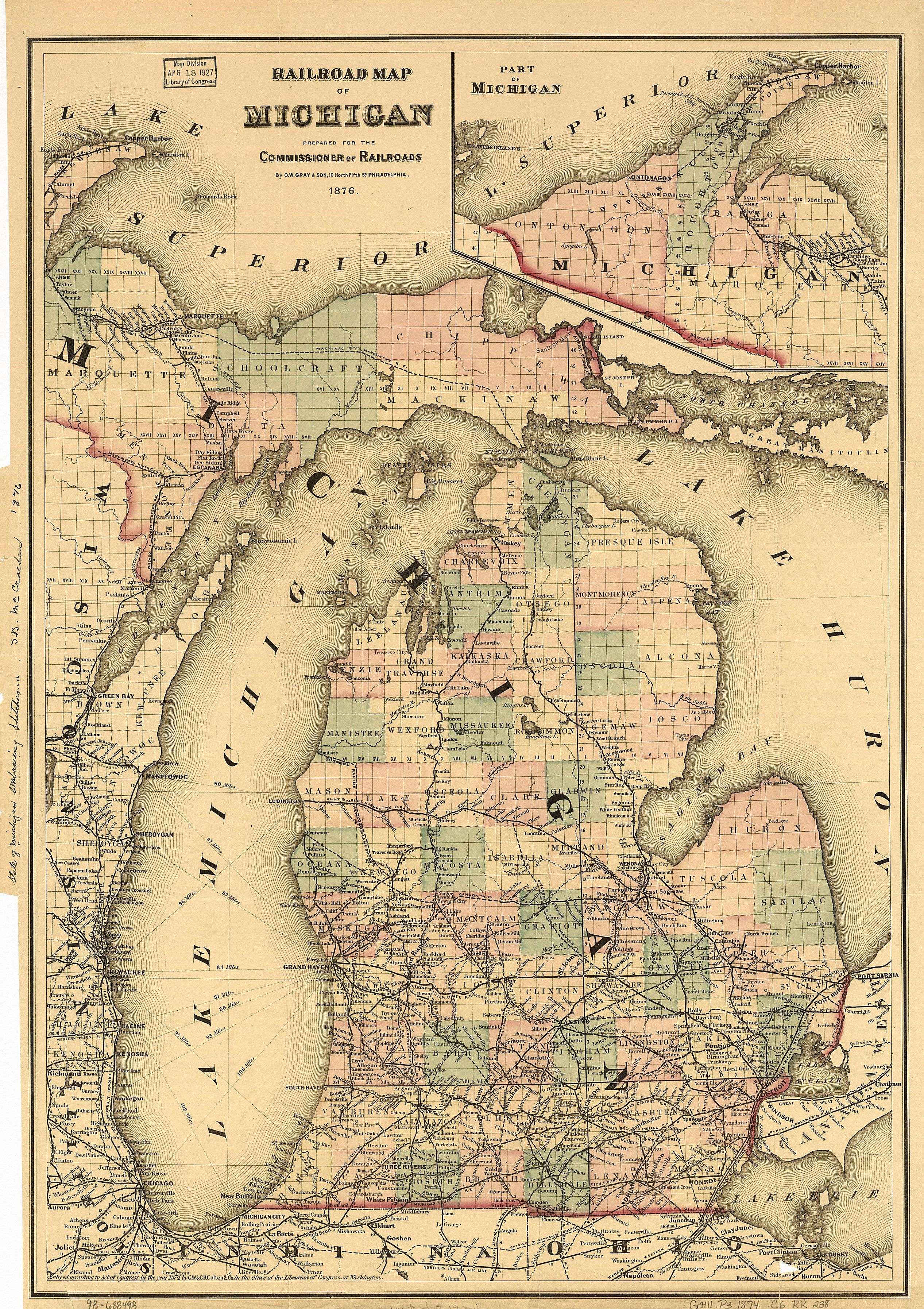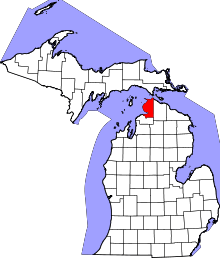Petoskey, Michigan
| Petoskey, Michigan | |
|---|---|
| City | |
| City of Petoskey[1] | |
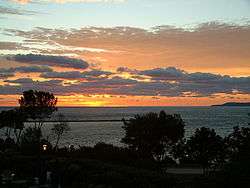  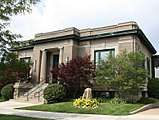 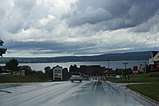  From left to right: The Little Traverse Bay at sunset, the Northern Michigan Regional Hospital, a panorama from US 131, a sign on US 31, the local public library, and the Bear River which flows through Petoskey; the Mitchell Street Bridge is in the background. | |
 Location in the U.S. state of Michigan | |
| Coordinates: 45°22′24″N 84°57′19″W / 45.37333°N 84.95528°WCoordinates: 45°22′24″N 84°57′19″W / 45.37333°N 84.95528°W | |
| Country | United States of America |
| State | Michigan |
| County | Emmet |
| Government | |
| • Mayor | John Murphy[2] |
| Area[3] | |
| • Total | 5.29 sq mi (13.70 km2) |
| • Land | 5.09 sq mi (13.18 km2) |
| • Water | 0.20 sq mi (0.52 km2) |
| Elevation | 666 ft (202 m) |
| Population (2010)[4] | |
| • Total | 5,670 |
| • Estimate (2016)[5] | 5,749 |
| • Density | 1,100/sq mi (410/km2) |
| Time zone | UTC-5 (EST) |
| • Summer (DST) | UTC-4 (EDT) |
| ZIP code | 49770 |
| Area code(s) | 231 Exchanges: 347,348,439,487 |
| FIPS code | 26-63820[6] |
| GNIS feature ID | 0634731[7] |
| Website | http://www.petoskey.us/ |
Petoskey is a city and coastal resort community in the U.S. state of Michigan. The population was estimated at approximately close to 5,670 at the 2010 census. It is the county seat of Emmet County.[8]
History
Odawa inhabitants
The Little Traverse Bay area was long inhabited by indigenous peoples, including the Odawa people. The name "Petoskey" is said to mean "where the light shines through the clouds" in the language of the Odawa. However it is more likely that the town was named for the Joseph Petoskey family of Poland. The original Petoskey family posterity still reside in the town. Yet the romantic myth that the town was named for the Odawa chief is good for tourism. After the 1836 Treaty of Washington, Odawa Chief Ignatius Petosega (1787–1885) took the opportunity to purchase lands near the Bear River. Petosega's father was Antoine Carre, a French Canadian fur trader and his mother was Odawa.[10]
Early Presbyterian Missions
By the 1850s, several religious groups had established missions near the Little Traverse Bay. A Mormon offshoot had been based at Beaver Island, the Jesuit missionaries had been based at L'arbor Croche and Michilimackinac, with a Catholic presence in Harbor Springs, then known as "Little Traverse".[11] Andrew Porter, a Presbyterian missionary, arrived at the village of Bear River (as it was then called) in 1852.[12][13]
Pioneer commercial interests
Amos Fox and Hirem Obed Rose were pioneer entrepreneurs who had made money both during the California Gold Rush and at Northport selling lumber and goods to passing ships. Originally based at Northport, Rose and Fox[14] (or Fox & Rose)[15] expanded their business interests to Charlevoix and Petoskey in the 1850s. Rose made additional money by being a part of a business partnership that extended the railroad from Walton Junction to Traverse City.[16] H.O. Rose, along with Archibald Buttars,[17] established a general merchandise business in Petoskey.[18] After the partnership split, Mr. Rose relocated to Petoskey and in 1873 started Petoskey's first dock.[19] When the Grand Rapids and Indiana Railroad was about to be extended into the Bay View area, Mr Rose purchased much land in that area as well as trolley cars to enable transport from Petoskey to Bay View.[20] Rose contributed to many firsts of Petoskey, including the first dock, the first general store, extensive lime quarries (Michigan Limestone Company, or Petoskey Lime Company[21] ),[22] erection of the Arlington Hotel, lumbering enterprises, first president of the village, harbor improvements in 1893,[23][24] and officiating at early commemorative public events.[25][26][27] Rose's influence on the city are also commemorated by the naming of the H. O. Rose room at the Perry Hotel.[28]
Later history
.jpg)
In the late 19th century, Petoskey was also the location where 50,000 passenger pigeon birds were killed daily in massive hunts, leading to their complete extinction in the early 20th century.[29] A state historical marker commemorates the events, including the last great nesting at Crooked Lake in 1878.[30] One hunter was reputed to have personally killed "a million birds" and earned $60,000, the equivalent of $1 million today.[31]
Petoskey is also famous for a high concentration of Petoskey stones, the state stone of Michigan. Notable natives are information theorist Claude Shannon, Civil War historian Bruce Catton and actress Megan Boone, star of the NBC television series The Blacklist (2013). The city is the boyhood home of singer-songwriter Sufjan Stevens.
This city was the northern terminus of the Chicago and West Michigan Railway.
The Petoskey stone is named after Odawa Chief Ignatius Petosega (1787–1885). With members descended from the numerous bands in northern Michigan, the Little Traverse Bay Band is a federally recognized tribe that has its headquarters at nearby Harbor Springs, Michigan. It also owns and operates a gaming casino in Petoskey.
Geography

Part of Northern Michigan, Petoskey is on the southeast shore of the Little Traverse Bay of Lake Michigan at the mouth of the Bear River. According to the United States Census Bureau, the city has a total area of 5.29 square miles (13.70 km2), of which 5.09 square miles (13.18 km2) is land and 0.20 square miles (0.52 km2) is water.[3]
Demographics
| Historical population | |||
|---|---|---|---|
| Census | Pop. | %± | |
| 1880 | 1,815 | — | |
| 1890 | 2,872 | 58.2% | |
| 1900 | 5,285 | 84.0% | |
| 1910 | 4,778 | −9.6% | |
| 1920 | 5,064 | 6.0% | |
| 1930 | 5,740 | 13.3% | |
| 1940 | 6,019 | 4.9% | |
| 1950 | 6,468 | 7.5% | |
| 1960 | 6,138 | −5.1% | |
| 1970 | 6,342 | 3.3% | |
| 1980 | 6,097 | −3.9% | |
| 1990 | 6,056 | −0.7% | |
| 2000 | 6,080 | 0.4% | |
| 2010 | 5,670 | −6.7% | |
| Est. 2016 | 5,749 | [5] | 1.4% |
| U.S. Decennial Census[32] | |||
2010 census
As of the census[4] of 2010, there were 5,670 people, 2,538 households, and 1,319 families residing in the city. The population density was 1,113.9 inhabitants per square mile (430.1/km2). There were 3,359 housing units at an average density of 659.9 per square mile (254.8/km2). The racial makeup of the city was 91.7% White, 0.7% African American, 4.7% Native American, 0.4% Asian, 0.5% from other races, and 2.1% from two or more races. Hispanic or Latino of any race were 1.9% of the population.
There were 2,538 households of which 24.3% had children under the age of 18 living with them, 36.7% were married couples living together, 11.8% had a female householder with no husband present, 3.5% had a male householder with no wife present, and 48.0% were non-families. 39.2% of all households were made up of individuals, and 12.2% had someone living alone who was 65 years of age or older. The average household size was 2.10 and the average family size was 2.81.
The median age in the city was 39.8 years. 19.4% of residents were under the age of 18; 11.9% were between the ages of 18 and 24; 24.5% were from 25 to 44; 28.1% were from 45 to 64; and 16.1% were 65 years of age or older. The gender makeup of the city was 47.3% male and 52.7% female.
2000 census
As of the census[6] of 2000, there were 6,080 people, 2,700 households, and 1,447 families residing in the city. The population density was 1,210.9 per square mile (467.6/km²). There were 3,342 housing units at an average density of 665.6 per square mile (257.0/km²). The racial makeup of the city was 94.18% White, 0.33% African American, 3.17% Native American, 0.81% Asian, 0.02% Pacific Islander, 0.20% from other races, and 1.30% from two or more races. Hispanic or Latino of any race were 1.17% of the population.
There were 2,700 households out of which 27.5% had children under the age of 18 living with them, 39.8% were married couples living together, 11.0% had a female householder with no husband present, and 46.4% were non-families. 39.4% of all households were made up of individuals and 14.6% had someone living alone who was 65 years of age or older. The average household size was 2.14 and the average family size was 2.89.
In the city, the population was spread out with 23.0% under the age of 18, 9.6% from 18 to 24, 28.5% from 25 to 44, 21.7% from 45 to 64, and 17.3% who were 65 years of age or older. The median age was 39 years. For every 100 females, there were 85.6 males. For every 100 females age 18 and over, there were 81.2 males.
The median income for a household in the city was $33,657, and the median income for a family was $48,168. Males had a median income of $35,875 versus $25,114 for females. The per capita income for the city was $20,259. About 6.6% of families and 12.0% of the population were below the poverty line, including 8.6% of those under age 18 and 8.4% of those age 65 or over.
Transportation
Airports
- The nearest airports with scheduled passenger service are in Pellston Regional Airport[33] and Traverse City Cherry Capital Airport.
Bus
- Indian Trails provides daily intercity bus service between St. Ignace and East Lansing, Michigan[34] and between Grand Rapids, Michigan and Petoskey.[35] Transfer between the two lines is possible in Petoskey.
Rail
- Freight rail service to Petoskey is limited and provided by the Tuscola and Saginaw Bay Railway (TSBY); however, the tracks are owned by the state of Michigan in order to preserve rail service in northern Michigan. Freight traffic includes plastic pellets delivered to a rail/truck transload facility for Petoskey Plastics. Occasional passenger/special excursion trains to Petoskey occur every now and then. Historically, the Northern Arrow and other rail lines provided passenger traffic to Petoskey and Bay View, Michigan from as far as Chicago and St. Louis, but these were discontinued in the late 20th century.
Marina
- The City of Petoskey Department of Parks and Recreation operates a 144-slip marina located in Bayfront Park. The marina offers seasonal and transient slips, gasoline, diesel fuel, boat launch, wireless internet, 30/50 AMP power, water, pump-out, restroom/showers, playground and adjacent park grounds. The Gaslight District is connected to Bayfront Park via a pedestrian tunnel. The marina received initial designation as a "Michigan Clean Marina"[36] in May 2007 and was recertified in 2010.
Major highways





Education
Among the many colleges in Michigan includes North Central Michigan College, located in Petoskey. The public school system consists of a high school, a middle school, and four elementary schools. Additionally, Petoskey Public Schools has a Montessori education building. [37]
Notable people
- Megan Boone, actress, star of NBC series The Blacklist
- Katie Brown, television host
- Bruce Catton, U.S. Civil War historian
- Alan Hewitt, musician and keyboardist for the Moody Blues, formerly worked with Earth, Wind and Fire[38][39]
- Herb Orvis, NFL defensive tackle 1972-81, member of College Football Hall of Fame[40]
- Claude Shannon, father of information theory
- Hal Smith, voice actor, Otis Campbell on The Andy Griffith Show
- Sufjan Stevens, singer-songwriter
Media
- Newspaper
- Magazines
- Traverse, is published monthly with a focus on regional interests.
- Local AM radio
- WLDR (750) - country; simulcast of WLDR-FM Traverse City
- WJML (1110) - Talk
- WMKT (1270) - News/Talk (licensed to Charlevoix, studios in Petoskey)
- WMBN (1340) - Sports Talk Radio
- Local FM radio
- WTLI (89.3) - contemporary Christian "Smile FM"
- WTCK (90.9) - Catholic religious (Charlevoix)
- WJOG (91.3) - contemporary Christian "Smile FM"
- WBCM (93.5) - country; simulcast of WTCM-FM Traverse City
- W237DA (95.3) - translator of WFDX-FM Atlanta (classic hits)
- WLXT (96.3) - adult contemporary
- WKLZ (98.9) - classic rock; simulcast of WKLT-FM Kalkaska
- W259AH (99.7) - translator of WPHN-FM Gaylord (religious)
- WICV (100.9) - classical (East Jordan); simulcast of WIAA-FM Interlochen
- WCMW (103.9) - CMU Public Radio (Harbor Springs)
- WKHQ (105.9) - CHR/top 40 (licensed to Charlevoix, studios in Petoskey)
- WLJD (107.9) - Christian (Charlevoix); simulcast of WLJN-FM
Climate
This climatic region has large seasonal temperature differences, with warm to hot (and often humid) summers and cold (sometimes severely cold) winters. According to the Köppen Climate Classification system, Petoskey has a humid continental climate, abbreviated "Dfb" on climate maps.[41]
| Climate data for Petoskey, Michigan | |||||||||||||
|---|---|---|---|---|---|---|---|---|---|---|---|---|---|
| Month | Jan | Feb | Mar | Apr | May | Jun | Jul | Aug | Sep | Oct | Nov | Dec | Year |
| Average high °F (°C) | 28 (−2) |
29 (−2) |
38 (3) |
51 (11) |
62 (17) |
71 (22) |
76 (24) |
76 (24) |
69 (21) |
57 (14) |
44 (7) |
33 (1) |
53 (12) |
| Average low °F (°C) | 15 (−9) |
13 (−11) |
21 (−6) |
33 (1) |
42 (6) |
53 (12) |
57 (14) |
58 (14) |
51 (11) |
42 (6) |
32 (0) |
22 (−6) |
37 (3) |
| Average precipitation inches (mm) | 2.1 (53) |
1.4 (36) |
1.7 (43) |
2.5 (64) |
2.7 (69) |
2.8 (71) |
2.8 (71) |
3.3 (84) |
3.8 (97) |
3.1 (79) |
2.7 (69) |
2.4 (61) |
31.4 (798) |
| Source: Weatherbase [42] | |||||||||||||
In popular culture
Petoskey and the surrounding area are notable in 20th-century U.S. literature as the setting of several of the Nick Adams stories by Ernest Hemingway, who spent his childhood summers on nearby Walloon Lake. They are the setting for certain events in Jeffrey Eugenides' 2002 novel Middlesex, which also features Detroit and its suburban areas.
References
- ↑ "Wayback Machine". March 22, 2016.
- ↑ "City Council Profiles". Petoskey.us. Archived from the original on April 5, 2014. Retrieved November 25, 2013.
- 1 2 "US Gazetteer files 2010". United States Census Bureau. Archived from the original on January 24, 2012. Retrieved November 25, 2012.
- 1 2 "American FactFinder". United States Census Bureau. Retrieved November 25, 2012.
- 1 2 "Population and Housing Unit Estimates". Retrieved June 9, 2017.
- 1 2 "American FactFinder". United States Census Bureau. Retrieved January 31, 2008.
- ↑ "US Board on Geographic Names". United States Geological Survey. October 25, 2007. Retrieved January 31, 2008.
- ↑ "Find a County". National Association of Counties. Retrieved June 7, 2011.
- ↑ Kilborn, Harriet. "History of Emmet County". Emmet County website. Retrieved 7 April 2016.
- ↑ Vogel, Virgil J. (1986). Indian Names in Michigan, pp. 45–46. University of Michigan Press. ISBN 0-472-06365-0.
- ↑ http://www.petoskeysfx.org/history.html "The first Catholic Church was built in Petoskey around 1859 by Father Sifferath, who was stationed in Harbor Springs. "
- ↑ Hellmann, Paul T. (2005). Historical Gazetteer of the United States. New York: Routledge (Taylor & Francis Books). p. 555. ISBN 0-415-93948-8. Retrieved 3 May 2016.
- ↑ "Little Traverse Bay". michmarkers.com. Retrieved 3 May 2016.
Petoskey, named for Chief Pe-to-se-ga of the Bear River Band was first settled in 1852 by Andrew Porter, a Presbyterian missionary.
- ↑ https://books.google.com/books?id=6WI0AQAAMAAJ&lpg=PA345&ots=zpJiYEhRjh&dq=H%20O%20Rose%20amos%20fox%20northport&pg=PA345#v=onepage&q=H%20O%20Rose%20amos%20fox%20northport&f=false Sprague's History of Grand Traverse and Leelanaw Counties, Michigan edited by Elvin L. Sprague, Mrs. George N. Smith p345
- ↑ https://books.google.com/books?id=QshKAQAAMAAJ&lpg=PA392&ots=Gi5sw0DqBr&dq=%22H%20O%20Rose%22%20petoskey%20-perry&pg=PA392#v=onepage&q=%22H%20O%20Rose%22%20petoskey%20-perry&f=false p392
- ↑ Bowen, B.F. (1905). Biographical History of Northern Michigan. Alpena County (Mich.): B.F. Bowen & Co. p. 499.
- ↑ https://books.google.com/books?id=3TG_sxY4KrgC&lpg=PA49&ots=lL5UptO61F&dq=%22H%20O%20Rose%22%20petoskey%20-perry&pg=PA49#v=onepage&q=%22H%20O%20Rose%22%20petoskey%20-perry&f=false OLD SETTLERS OF THE Grand Traverse Region By S. E. WAIT and W. S. ANDERSON p49
- ↑ Bowen, B.F. (1905). Biographical History of Northern Michigan. Alpena County (Mich.): B.F. Bowen & Co. pp. 482, 486–499.
- ↑ Bowen, B.F. (1905). Biographical History of Northern Michigan. Alpena County (Mich.): B.F. Bowen & Co. p. 498.
- ↑ https://books.google.com/books?id=UO5gAwAAQBAJ&lpg=PA30&ots=OuBsqtGaN2&dq=%22H%20O%20Rose%22%20petoskey%20-perry&pg=PA30#v=onepage&q=%22H%20O%20Rose%22%20petoskey%20-perry&f=false p30
- ↑ https://books.google.com/books?id=fTvYntmuiNsC&lpg=PA2672&ots=FefrP2mo2k&dq=%22H%20O%20Rose%22%20petoskey%20-perry&pg=PA2672#v=onepage&q=%22H%20O%20Rose%22%20petoskey%20-perry&f=false Report of the Chief of Engineers U.S. Army, Part 3 p2672
- ↑ https://books.google.com/books?id=eFHYAwAAQBAJ&lpg=PA5&ots=8e8tUMB-UZ&dq=Rose%20amos%20fox%20northport&pg=PA6#v=onepage&q&f=false p6
- ↑ https://books.google.com/books?id=CYc3AQAAIAAJ&lpg=PA2911&ots=f-78-72x_H&dq=%22H%20O%20Rose%22%20petoskey%20-perry%20hiram&pg=PA2911#v=onepage&q=%22H%20O%20Rose%22%20petoskey%20-perry%20hiram&f=false United States Congressional serial set, Issue 3202 p2911
- ↑ https://books.google.com/books?id=zCtHAQAAIAAJ&lpg=PA2944&ots=JW4l3C7aSp&dq=%22H%20O%20Rose%22%20petoskey%20-perry&pg=PA2944#v=onepage&q=%22H%20O%20Rose%22%20petoskey%20-perry&f=false Congressional Series of United States Public Documents, Volume 3634 p2944
- ↑ http://deemamafred.tripod.com/emhist.html [Welcoming the first train to Petoskey] on November 25, 1873, " H. 0. Rose was on hand to do the official "welcoming" honors."
- ↑ https://books.google.com/books?id=pD8zAQAAMAAJ&lpg=PA160&ots=r-loV5C8Ra&dq=%22H%20O%20Rose%22%20petoskey%20-perry&pg=PA160#v=onepage&q=%22H%20O%20Rose%22%20petoskey%20-perry&f=false The Traverse Region, Historical and Descriptive: With Illustrations p160
- ↑ The Traverse Region, historical and descriptive. Chicago: H. R. Page & Co.,. 1884. pp. 154–155. Archived from the original on February 3, 2017. Retrieved February 3, 2017.
- ↑ "H.O. Rose Dining Room, Perry Hotel Restaurant Petoskey".
- ↑ Department of Vertebrate Zoology, National Museum of Natural History in cooperation with the Public Inquiry Mail Service (March 2001). "The Passenger Pigeon". Smithsonian Institution. Retrieved February 28, 2012.
- ↑ "Last Great Gathering of Passenger Pigeons, Crooked Lake Nesting Colony". Petoskey, Michigan: Michigan state historical marker. Retrieved February 29, 2012.
- ↑ "Was Martha the last "Pigean de passage"? lifeofbirds.com". Life of Birds website. January 6, 2007. Archived from the original on October 9, 2007. Retrieved February 29, 2012. at Wayback Machine
- ↑ "Census of Population and Housing". Census.gov. Retrieved June 4, 2015.
- ↑ "Pellston Regional Airport Serving Northern Michigan Emmet County". Pellstonairport.com. Retrieved November 25, 2013.
- ↑ "EAST LANSING-PETOSKEY-ST. IGNACE" (PDF). Indian Trails. January 15, 2013. Archived from the original (PDF) on June 29, 2014. Retrieved February 27, 2013.
- ↑ "GRAND RAPIDS-CADILLAC-TRAVERSE CITY-PETOSKEY" (PDF). Indian Trails. January 15, 2013. Retrieved February 28, 2013.
- ↑ "Certified Michigan Clean Marinas". Michigan Sea Grant. Archived from the original on April 12, 2013. Retrieved November 25, 2013.
- ↑ "Public Schools of Petoskey". moodle.petoskeyschools.org.
- ↑ "Music". alanhewitt.com.
- ↑ Sutton, Rene (April 2013). "Alan Hewitt — Featured Smooth Jazz Artist Archives Alan Hewitt – The Musical Force of Nature". The Smooth Jazz Ride. Archived from the original on January 4, 2015. Retrieved January 4, 2015.
- ↑ "Herb Orvis Career stats". NFL.com, National Football League.
- ↑ "Petoskey, Michigan Köppen Climate Classification". Weatherbase. Retrieved November 25, 2013.
- ↑ "Weatherbase.com". Weatherbase. 2013. Retrieved on September 22, 2013.
Further reading
- Cappel, Constance, Hemingway in Michigan, 1999, Petoskey, MI: Little Traverse Historical Society
- Cappel, Constance, ed., 2006 Odawa Language and Legends, Philadelphia, PA: Xlibris
- Cappel, Constance, 2007, The Smallpox Genocide of the Odawa Tribe at L'Arbre Croche, 1763: A History of a Native American People, Lewiston, NY: Ediwin Mellen Press.
- Clarke Historical Library, Central Michigan University, Bibliography on Emmet County.[1]
External links
| Wikimedia Commons has media related to Petoskey, Michigan. |

- Petoskey Area Visitors Bureau
- City of Petoskey Web Site - information, news, and events
- ↑ "Home | Central Michigan University". Clarke.cmich.edu. October 7, 2010. Retrieved November 25, 2013.
